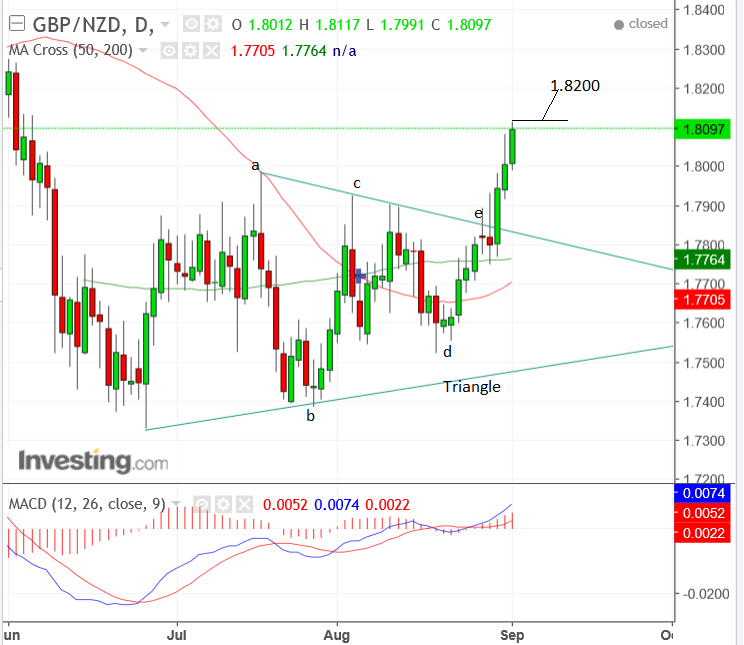GBP/NZD: Forecast, Data, and News Over the Next Five Days

The New Zealand Dollar (Kiwi) has spectacularly broken out of its long-term sideways range and moved higher.
The breakout was mainly due to a depreciation of the Kiwi rather than an appreciation of the Pound.
The New Zealand currency is under pressure from myriad risk factors, chief of which, however, appears to be political risk associated with the general election on September 23.
According to analysts, whichever major party wins, the probabilities are that their agenda will encompass anti-Kiwi policies, leading to a lose-lose assessment for the currency.
Further, loses are possible versus Sterling due to increasing Bank of England (BOE) rate hike expectations, given fuel by recent comments from BOE's Michael Saunders who thought it was high time for a rate rise.
The chart of GBP/NZD shows how a triangle pattern formed for most of 2017 but has now been broken out of.
According to traditional technical methods of calculating the reach of a triangle breakout the rally is probably not finished yet - in other words, there could be further upside.
On balance we see the uptrend extending, with a break above the current 1.8117 highs providing confirmation of more upside to a target at 1.8200.

News, Events, and Data for the New Zealand Dollar
The week kicks off with Global Dairy Prices on Tuesday at 15.30 BST, when prices are fixed by international auction.
In the previous auction prices were recorded as having fallen by -0.4%.
Dairy products are New Zealand's premium export, so any rise in prices is likely to help the Kiwi, although they would have to be considerable to make a difference.
Thursday, September 7 sees the release of New Zealand Manufacturing Sales in Q2, which is out at 23.45 BST.
In Q1 Manufacturing Sales registered a -0.1% fall, whilst in Q2 they are forecast to rise by 1.5% by Trading Economics.
News, Data, and Events for the Pound
On Monday, Construction PMI for August is out at 9.30 BST, and on Tuesday Services PMI at the same time.
PMI's are surveys of purchasing managers and provide a snapshot of how conditions are in a particular industry sector.
A score of over 50 indicates expansion and under 50 indicates contraction.
Construction is forecast to come out at 52.0 in August from 51.9 in July, and Services at 53.5 from 53.8 in July.
Thursday, September 7 witnesses the release of Halifax House prices in August at 8.30 BST.
Friday, September 8, sees the release of Industrial and Manufacturing Production for July, at 9.30 BST.
The former is supposed to show a 0.2% rise and the latter a 0.3% rise.
The Trade Balance in July is out at the same time, and is expected to show a narrowing of the deficit to -11.9bn from -12.72bn previously.
Political pressure may also come to bear on Sterling as parliamentarians begin debating the 'Great Repeal Bill' on Thursday, which is the legislation which will take the UK out of the EU.
The Labour party is tabling amendments to the bill, which will lead to a softer Brexit and a few pro-European conservatives are thought to be supportive.
This could make it potentially more difficult for Theresa May's government to get the Bill passed, and there have been reports of the government trying to 'arm-twist' grumbling tory dissenters, who may even be plotting to overthrow the May leadership.
There is, therefore, a possibility of volatility for the Pound due to political uncertainty in the week ahead, particularly as the Brexit debate continues to grind on. While some progress has been made, there hasn't been enough to stir a long-awaited recovery in the Pound.




